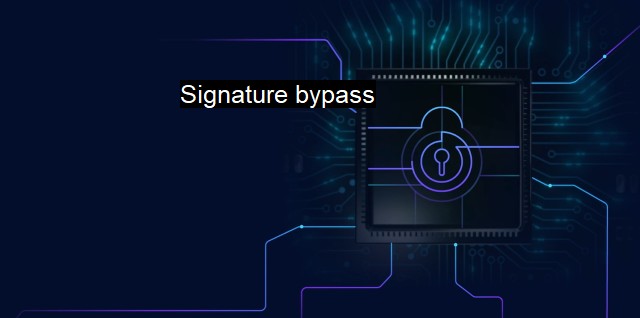What are Signature bypass?
The Risks of Signature Bypass in Cybersecurity and How to Prevent It
Signature bypass is a vital concept in the field of cybersecurity and antivirus programs. It refers to a method used by malicious software to evade detection by antivirus programs that rely on signature-based identification. This technique involves creating, altering, or obfuscating the 'signature' of a piece of malicious software, making it unrecognizable to antivirus software. Understanding this concept requires an appreciation for what a 'signature' means in the realm of cybersecurity and how antivirus programs typically identify threats.a signature is a specific pattern that identifies a particular virus, worm, malware, or other threats. It can be thought of as the digital fingerprint of the malicious software. Antivirus software typically operates by defining harmful programming through these unique identifiers or structures, detecting them, and promptly removing or neutralizing them.
Attackers who design and propagate malicious software aren't passive. They are aware of antivirus programs' methodologies and structure their software to bypass these traps. This is where signature bypass comes into play.
The mechanism of signature bypass can vary, but one common approach is code obfuscation. Code obfuscation involves making the code hard to understand and interpret, often through adding redundant or extraneous code, rejigging the operating flow, or encrypting elements of the code. All this is done with the aim of hiding the malicious intent of the software and the signature the antivirus software would be looking for. The result is that the disguised harmful code gains access to the system without being flagged as a threat.
Another method of signature bypass is using polymorphic code. This involves altering the code or encryption of the malicious software every time it is executed, yet without changing its final output or functionality. This generates a different signature for the same piece of harmful code each time, duping the antivirus reliant on recognizing predefined signatures.
And then there is metamorphic malware that goes one step further. Not only does it change its signatures, but it also changes its internal code, thus making every iteration appear as a totally separate and new piece of software.
The existence and rise of signature bypass techniques represent a constant challenge to cybersecurity professionals and entities responsible for creating antivirus software. It's a high-stakes game of cat and mouse, with attackers continually innovating methods to circumvent the latest defenses.
To counter these advanced threats, antivirus companies have had to equally evolve. Relying only on signature-based detection engines is now considered outdated. Instead, the trend is to utilise artificial intelligence and machine learning for dynamic threat detection. This offers the advantage of detecting malware through behavioral analysis, rather than just via static signature matches.
Virtual sandboxing is another strategy being used. Suspicious programs are let to perform in a secure, virtual sandbox where their behavior can be monitored and analyzed without risking the main system.
To sum up, signature bypass represents the sophisticated tactics employed by malicious hackers to fool antivirus programs. As these methods become increasingly refined, the counter strategies of cybersecurity professionals also need to grow, invoking a broader range of methods beyond simple signature identification.
In this evolving scenario, the call of the hour is a balanced mix of traditional signature-based detection and novel AI and machine learning-based approach. But one thing remains clear: signature bypass continues to illustrate that it's often about staying one step ahead of the curve.

Signature bypass FAQs
What is signature bypass in cybersecurity?
Signature bypass refers to a technique used by attackers to avoid detection by antivirus software. This technique involves modifying the malicious code or file in such a way that it appears different from its original form, thereby bypassing the signature-based scanning used by most antivirus solutions.Why is signature bypass a concern for cybersecurity?
Signature bypass is a concern for cybersecurity as it allows attackers to evade antivirus software and deliver their malicious payloads undetected. This makes it easier for attackers to infiltrate networks, steal sensitive data or cause damage to systems. Additionally, signature-based detection is still the primary defense mechanism used by many antivirus solutions, making them ineffective against attacks that use signature bypass.How can organizations protect against signature bypass attacks?
To protect against signature bypass attacks, organizations should employ a multi-layered approach to cybersecurity. This includes using advanced threat detection solutions that go beyond signature-based detection, keeping their security software up-to-date, educating employees on the risks of phishing and social engineering attacks, and regularly conducting vulnerability assessments and penetration testing.What are some examples of signature bypass techniques?
Some examples of signature bypass techniques include file obfuscation, code encryption, polymorphism, and metamorphism. File obfuscation involves modifying the file's metadata to make it appear different to the antivirus scanner. Code encryption involves encrypting the malicious code to make it unreadable to signature-based scanners. Polymorphism involves changing the code's structure or behavior every time it is executed, making it difficult to detect. Metamorphism involves modifying the code's instructions and structure while preserving its functionality.| | A | | | B | | | C | | | D | | | E | | | F | | | G | | | H | | | I | | | J | | | K | | | L | | | M | |
| | N | | | O | | | P | | | Q | | | R | | | S | | | T | | | U | | | V | | | W | | | X | | | Y | | | Z | |
| | 1 | | | 2 | | | 3 | | | 4 | | | 7 | | | 8 | | |||||||